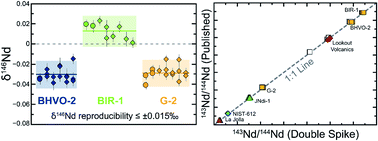当前位置:
X-MOL 学术
›
J. Anal. At. Spectrom.
›
论文详情
Our official English website, www.x-mol.net, welcomes your
feedback! (Note: you will need to create a separate account there.)
Simultaneous measurement of neodymium stable and radiogenic isotopes from a single aliquot using a double spike
Journal of Analytical Atomic Spectrometry ( IF 3.1 ) Pub Date : 2019/12/18 , DOI: 10.1039/c9ja00308h Alex J. McCoy-West 1, 2, 3, 4, 5 , Marc-Alban Millet 6, 7, 8, 9 , Geoff M. Nowell 5, 9, 10, 11 , Oliver Nebel 1, 2, 3, 4 , Kevin W. Burton 5, 9, 10, 11
Journal of Analytical Atomic Spectrometry ( IF 3.1 ) Pub Date : 2019/12/18 , DOI: 10.1039/c9ja00308h Alex J. McCoy-West 1, 2, 3, 4, 5 , Marc-Alban Millet 6, 7, 8, 9 , Geoff M. Nowell 5, 9, 10, 11 , Oliver Nebel 1, 2, 3, 4 , Kevin W. Burton 5, 9, 10, 11
Affiliation

|
Neodymium (Nd) stable isotopes have the potential to provide new constraints on a diverse range of geological processes from planetary formation and magmatic differentiation to weathering and ocean circulation. In this contribution, we present a technique for the high-precision measurement of Nd stable isotope ratios by thermal ionisation mass spectrometry (TIMS). We use a 145Nd–150Nd double spike (DS), composed of 28% 145Nd and 67% 150Nd, to correct for mass dependent fractionation resulting from sample preparation and mass spectrometry. Isotope ratios are expressed as δ146Nd which is the per mil deviation in the measured 146Nd/144Nd ratio relative to reference material JNdi-1. Repeated analyses show that an internal precision (n = 400 cycles; 2 se) of ≤0.005‰ on δ146Nd can be achieved in agreement with theoretical predictions. An interlaboratory comparison of the primary standard JNdi-1 over a three-year period shows that resolvable offsets in δ146Nd are induced within and between mass spectrometers as the result of systematic biases in the efficiency of the Faraday collectors. Following normalisation of the data to JNdi-1 = 0‰ the long-term reproducibility of δ146Nd on a range of international reference materials processed through chemical separation is better than ±0.015‰ (2 sd). In addition to stable isotope compositions this method allows for the simultaneous measurement of 143Nd/144Nd with a precision of ≤11 ppm. Over a wide range of 143Nd/144Nd (0.5118–0.5132) the DS analyses here agree within analytical uncertainty with published values using conventional techniques. To allow the accurate age correction of these radiogenic isotope compositions in ancient geological samples (>2 Ga) here for the first time we have combined a DS and an elemental tracer spike. A 149Sm tracer spike was calibrated and used to obtain isotope dilution Sm concentrations and ultimately parent-daughter ratios. Measured Sm–Nd ratios are within uncertainty of previous estimates for a range of reference materials, with the addition of the Sm spike having no resolvable effect on δ146Nd values. This technique allows δ146Nd, 143Nd/144Nd and Sm/Nd to be obtained simultaneously, therefore allowing constrains to be placed on both the source or age of a material and the processes involved in its formation.
中文翻译:

使用双尖峰同时测量来自等分试样的钕稳定同位素和放射性同位素
钕(Nd)稳定同位素有可能对从行星形成和岩浆分化到风化和海洋环流的各种地质过程提供新的约束。在此贡献中,我们提出了一种通过热电离质谱(TIMS)高精度测量Nd稳定同位素比的技术。我们使用由28%145 Nd和67%150 Nd组成的145 Nd– 150 Nd双峰(DS)校正样品制备和质谱分析产生的质量相关分馏。同位素比率表示为δ 146的Nd这是在测得的每密耳偏差146的Nd / 144相对于参考材料JNdi-1的Nd比。重复分析表明,一个内部精度(Ñ = 400个循环; 2 SE)的≤0.005‰上δ 146钕可以与理论预测协议来实现。主标准JNDI-1的实验室间比在三年期间显示,在解析的偏移δ 146的Nd被内和质谱仪作为法拉第收集器的效率系统偏差的结果之间感应。以下的数据的归一化到JNDI-1 = 0的‰的长期再现性δ 146通过化学分离处理的一系列国际参考材料中的Nd优于±0.015‰(2 sd)。除了稳定的同位素组成,该方法还可以同时测量143 Nd / 144 Nd,精度≤11 ppm。在这里,DS分析在143 Nd / 144 Nd(0.5118-0.5132)的宽范围内,使用常规技术在分析不确定度内与公布的值相吻合。为了在此处首次对古代地质样品(> 2 Ga)中这些放射性同位素组成进行准确的年龄校正,我们将DS和元素示踪剂尖峰相结合。A 149校准了Sm示踪剂尖峰,并用于获得同位素稀释Sm浓度以及最终的母子比例。测量的Sm-Nd比对于一个范围的参考材料的先前估计的不确定性范围内,添加的SM尖峰具有上没有可分辨的效果δ 146的Nd值。这种技术允许δ 146的Nd,143的Nd / 144要同时获得的Nd和Sm /钕,因此允许被放置在材料的两个源或年龄和参与其形成的过程在约束。
更新日期:2020-02-13
中文翻译:

使用双尖峰同时测量来自等分试样的钕稳定同位素和放射性同位素
钕(Nd)稳定同位素有可能对从行星形成和岩浆分化到风化和海洋环流的各种地质过程提供新的约束。在此贡献中,我们提出了一种通过热电离质谱(TIMS)高精度测量Nd稳定同位素比的技术。我们使用由28%145 Nd和67%150 Nd组成的145 Nd– 150 Nd双峰(DS)校正样品制备和质谱分析产生的质量相关分馏。同位素比率表示为δ 146的Nd这是在测得的每密耳偏差146的Nd / 144相对于参考材料JNdi-1的Nd比。重复分析表明,一个内部精度(Ñ = 400个循环; 2 SE)的≤0.005‰上δ 146钕可以与理论预测协议来实现。主标准JNDI-1的实验室间比在三年期间显示,在解析的偏移δ 146的Nd被内和质谱仪作为法拉第收集器的效率系统偏差的结果之间感应。以下的数据的归一化到JNDI-1 = 0的‰的长期再现性δ 146通过化学分离处理的一系列国际参考材料中的Nd优于±0.015‰(2 sd)。除了稳定的同位素组成,该方法还可以同时测量143 Nd / 144 Nd,精度≤11 ppm。在这里,DS分析在143 Nd / 144 Nd(0.5118-0.5132)的宽范围内,使用常规技术在分析不确定度内与公布的值相吻合。为了在此处首次对古代地质样品(> 2 Ga)中这些放射性同位素组成进行准确的年龄校正,我们将DS和元素示踪剂尖峰相结合。A 149校准了Sm示踪剂尖峰,并用于获得同位素稀释Sm浓度以及最终的母子比例。测量的Sm-Nd比对于一个范围的参考材料的先前估计的不确定性范围内,添加的SM尖峰具有上没有可分辨的效果δ 146的Nd值。这种技术允许δ 146的Nd,143的Nd / 144要同时获得的Nd和Sm /钕,因此允许被放置在材料的两个源或年龄和参与其形成的过程在约束。











































 京公网安备 11010802027423号
京公网安备 11010802027423号